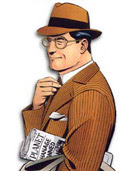
From Time:
By Tom Wolfe
 Barely 40 when he edited the New York Herald Tribune, he had the posture of an 80-year-old. His body was skin and bones, nourished solely by cigarettes, cigarettes, cigarettes, as far as I could tell. Everybody said he didn't actually speak. He mumbled. In fact, that odd sound was the audible tone of the megavolt current generated by his passionate fascination with the human comedy.
Barely 40 when he edited the New York Herald Tribune, he had the posture of an 80-year-old. His body was skin and bones, nourished solely by cigarettes, cigarettes, cigarettes, as far as I could tell. Everybody said he didn't actually speak. He mumbled. In fact, that odd sound was the audible tone of the megavolt current generated by his passionate fascination with the human comedy.Just 20 minutes before deadline one evening, I made it back to the city room with, if I do say so, a hot story about the notorious numbers racketeer Newsboy Moriarty. In the first sentence, I took readers down into the lint at the bottom of Moriarty's loot-lined trouser pockets. Bellows must have loved that lint as much as I did, because as I was finishing the second sheet of copy, he materialized and said in his electric whisper, "Keep it coming. Everything you've got. I don't care how long it is. I want it all." In my 53 years as a writer, that remains the greatest compliment I have ever received.
Bellows loved hot stories written in acrobatic prose. Only under Bellows could the Trib's Sunday supplement, New York, have turned into a showcase for the radical experiment now called the New Journalism. Bellows' Trib became the hottest newspaper in America.
The only thing Bellows liked better than high style and muscular editorial content was a fight. He would poke any eye to start one. In 1965 I wrote a story for New York having some sport with William Shawn, editor of the New Yorker. The moment our issue came off the press, Bellows sent a copy to Shawn. The detonator was a little inscription on the calling card that accompanied it: "With my compliments, James G. Bellows."
Oh, and all those cigarettes? Bellows died March 6 at 86, without ever having experienced so much as a dry cough.
Newsman Bellows shaped glory days of print journalism
By Tony Castro
 The names most often associated with Jim Bellows, the fabled newspaper editor who died last Friday at the age of 86, were Jimmy Breslin and Tom Wolfe - the legendary journalists whose early careers he helped shape into the biggest bylines in the country.
The names most often associated with Jim Bellows, the fabled newspaper editor who died last Friday at the age of 86, were Jimmy Breslin and Tom Wolfe - the legendary journalists whose early careers he helped shape into the biggest bylines in the country. But the names I most associate with Jim are those of three artists who became indelibly linked with him in my memory the night he hosted a cocktail party at his Brentwood home for all his new hires at the Los Angeles Herald Examiner in February of 1978, not long after he became that newspaper's editor. [Click for MORE]
Sphere: Related Content










